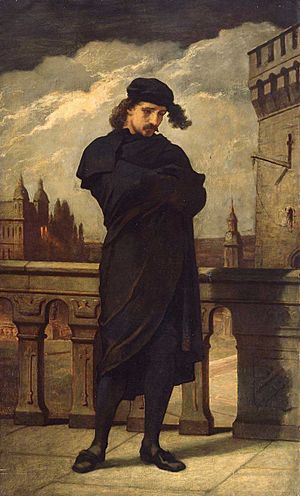Protagonist facts for kids
A protagonist is the main character in a story. This character makes important choices that move the story forward. They often face the biggest challenges. If a story has smaller side stories, each of those might have its own main character too.
The protagonist is the character whose journey the reader or audience cares about the most. They are usually opposed by the antagonist. The antagonist creates problems and conflicts that test the protagonist, showing their strengths and weaknesses. This helps the protagonist grow and change throughout the story.
Contents
What Does Protagonist Mean?
The word protagonist comes from Ancient Greek. It means "one who plays the first part" or "chief actor." It combines two Greek words: "protos" meaning 'first' and "agonistes" meaning 'actor' or 'competitor'.
Protagonists in Ancient Greece
The idea of a protagonist first appeared in Ancient Greece. Early plays mostly had dancing and singing by a group called a chorus.
The Greek philosopher Aristotle wrote that a poet named Thespis changed this. He introduced one actor who would step out and talk with the chorus. This was the start of tragedy plays, around 536 BC.
Later, another poet named Aeschylus added a second actor to his plays. This created the idea of two characters talking to each other. Then, Sophocles added a third actor.
In Ancient Greece, the main actor (protagonist) was sometimes also the writer and director of the play. The word "hero" was different back then. It was used for a human who became like a god in a story.
Different Kinds of Protagonists
Not all protagonists are the same! They can be many different types of characters.
Hero or Heroine Protagonists
A hero (for a boy or man) or heroine (for a girl or woman) is a protagonist who is usually admired. They are known for their good deeds and noble qualities. Heroes are often seen as strong, brave, and honorable. They are typically the "good guys" in a story.
- Examples: Superman from DC Comics, and Katniss Everdeen from The Hunger Games.
Antihero Protagonists
An antihero is a main character who doesn't have the usual heroic qualities. They might not be very idealistic, brave, or moral. They can be flawed or even do bad things, but they are still the main character we follow.
- Examples: Holden Caulfield from The Catcher in the Rye, and Jay Gatsby from The Great Gatsby.
Tragic Hero Protagonists
A tragic hero is the main character in a tragedy play. These characters often have a flaw or make a mistake that leads to their downfall, even if they are noble.
- Examples: Oedipus from Oedipus Rex, and Prince Hamlet from Shakespeare's Hamlet.
Villain Protagonists
Sometimes, the main character is actually a villain! A villain protagonist is a bad guy who drives the story forward. Even though they are cruel, mean, or wicked, the story is told from their point of view.
- Examples: Humbert Humbert in Vladimir Nabokov's Lolita, and Richard III in William Shakespeare's play Richard III.
Supporting Protagonists
A supporting protagonist is a character who seems minor, but the story is told through their eyes. They might not be directly involved in all the main events. Instead, they tell the story while watching another character who seems to be the main focus.
- Example: Nick in The Great Gatsby tells the story, even though Gatsby is the central figure.
More Examples of Protagonists
- In Euripides' play Hippolytus, there are two protagonists. Phaedra is the main character in the first half. After she dies, her stepson, Hippolytus, becomes the main character for the rest of the play.
- In Shakespeare's play Romeo and Juliet, Romeo is the protagonist. We follow his journey as he tries to be with Juliet. Tybalt is an antagonist who tries to stop their relationship.
- In Shakespeare's play Hamlet, Prince Hamlet is the protagonist. He wants to get revenge for his father's murder. The antagonist is Claudius, who opposes Hamlet.
- Sometimes, a story might have a false protagonist. This character seems like the main one at first but then disappears unexpectedly. Marion in Alfred Hitchcock's film Psycho (1960) is a good example.
- A story can have many main characters. For example, Leo Tolstoy's War and Peace follows many different characters affected by a war.
- Protagonists don't always have to be human! In Richard Adams' book Watership Down, the main characters are a group of talking rabbits. Their leader, Hazel, is the protagonist.
See also
 In Spanish: Protagonista para niños
In Spanish: Protagonista para niños


